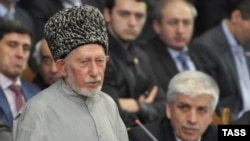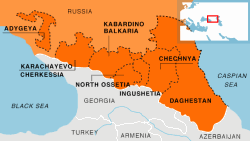As Daghestan's Sufis buried their spiritual leader on August 28, the sea of almost entirely male faces seemed to stretch to the horizon around his grave in the small town of Chirkeisk.
Observers put the number of mourners at more than 100,000 -- an almost unheard of crowd for a public figure in this small North Caucasus republic.
But Said Efendi Chirkeisky, born 74 years ago as Said Atsayev, was no ordinary mortal to his followers. He was the spiritual leader of Daghestan's official brand of Islam, Sufism, and regarded by his admirers as inspired by God.
Now, his death at the hands of a suicide bomber threatens to add new fuel to the cycle of insurgent violence and security crackdowns that is gripping this corner of the Russian Federation.
The suicide bomber who killed Chirkeisky and at least five of his followers on August 28 has been identified as Aminat Saprykina. Russian media quoted security officials as saying she was the wife of a fundamentalist Islamic militant who has long been on the police wanted list.
'Tragedy For Daghestan'
Aleksei Malashenko, an expert on Islam and the Caucasus at Moscow-based Carnegie Endowment for International Peace, called Chirkeisky a pillar of Dagestan's establishment-backed traditional Sufism, which is being challenged by Islamic militancy.
"He constructed good relations with the secular administration. He was very popular. He had pupils among the officials and even some ministers supported him," Malashenko says. "So, it is a tragedy for Daghestan because it shows a deep split between traditional and nontraditional Islam."
Malashenko says that Chirkeisky, who headed both the Naqshbandi and Shazali religious orders in Daghestan, had an estimated 10,000 to 50,000 religious pupils. Many of his pupils are members of Daghestan's security forces, creating a strong nexus between the official religious establishment and the republic's civil administration.
The religious leader's popularity was based on both his record as an Islamic scholar – though he personally neither read nor spoke Arabic – and his success as an author of spiritual poetry. He was also widely regarded as having a good disposition, patience, and willingness to receive any who came to him for help.
But Chirkeisky's frequent criticism of Wahabbism made him an assassination target for insurgents. He survived an assassination attempt in 2007. Salafi extremists termed him a regime puppet and militant websites welcomed his killing.
'Vicious Circle'
Liz Fuller, a Munich-based Caucasus expert who writes the "Caucasus Report" blog for RFE/RL, sees the assassination of Chirkeisky as part of a vicious circle of revenge killings in Daghestan that has continued for more than a decade.
She says the violence began in earnest after 1999 when Chechen guerrilla leader Shamil Basayev launched an incursion into Daghestan with the intention of proclaiming an independent North Caucasus Islamic state.
"After the invasion was repelled, the Daghestani parliament passed a law outlawing Wahabbism, which is the derogatory term for Salafism," Fuller says. "The police took it upon themselves to be the guardians of that law and over the years the militants have targeted almost exclusively the police and the police have retaliated by targeting not just the militants but anyone who is Salafi, even if they are absolutely peaceful. And this, of course, has become a vicious circle."
Numerous other religious figures have been killed over the past two years in Daghestan, including the imam of the central mosque in the city of Buinaksk in March. Clashes with militants and attacks on police occur almost daily.
With the death of the Sufi spiritual leader, the lines between the insurgency-related violence and tensions between the republic's majority Sufi community and still small but growing Salafi community risk becoming more blurred. His death sets back recent attempts by religious leaders on both sides to increase dialogue between their communities.
Fuller notes that Chirkeisky was a central part of those initiatives.
"There have been two attempts at dialogue between the two [religious communities]," she says. "There was one in the spring of last year that did not go anywhere and a second one that started late April this year that had Said Efandi [Chirkeisky's] backing. They drafted a sort of memorandum on how they would speak of each other with respect, and on how they would do what they could to try to defuse the tensions between them. But both the insurgents and the Interior Ministry set about sabotaging that."
Daghestan observed a day of mourning on August 29 for Chirkeisky and other victims of the suicide bombing. State flags flew at half-staff and all entertainment programs on TV and radio were canceled.
Observers put the number of mourners at more than 100,000 -- an almost unheard of crowd for a public figure in this small North Caucasus republic.
But Said Efendi Chirkeisky, born 74 years ago as Said Atsayev, was no ordinary mortal to his followers. He was the spiritual leader of Daghestan's official brand of Islam, Sufism, and regarded by his admirers as inspired by God.
Now, his death at the hands of a suicide bomber threatens to add new fuel to the cycle of insurgent violence and security crackdowns that is gripping this corner of the Russian Federation.
The suicide bomber who killed Chirkeisky and at least five of his followers on August 28 has been identified as Aminat Saprykina. Russian media quoted security officials as saying she was the wife of a fundamentalist Islamic militant who has long been on the police wanted list.
'Tragedy For Daghestan'
Aleksei Malashenko, an expert on Islam and the Caucasus at Moscow-based Carnegie Endowment for International Peace, called Chirkeisky a pillar of Dagestan's establishment-backed traditional Sufism, which is being challenged by Islamic militancy.
"He constructed good relations with the secular administration. He was very popular. He had pupils among the officials and even some ministers supported him," Malashenko says. "So, it is a tragedy for Daghestan because it shows a deep split between traditional and nontraditional Islam."
Malashenko says that Chirkeisky, who headed both the Naqshbandi and Shazali religious orders in Daghestan, had an estimated 10,000 to 50,000 religious pupils. Many of his pupils are members of Daghestan's security forces, creating a strong nexus between the official religious establishment and the republic's civil administration.
The religious leader's popularity was based on both his record as an Islamic scholar – though he personally neither read nor spoke Arabic – and his success as an author of spiritual poetry. He was also widely regarded as having a good disposition, patience, and willingness to receive any who came to him for help.
But Chirkeisky's frequent criticism of Wahabbism made him an assassination target for insurgents. He survived an assassination attempt in 2007. Salafi extremists termed him a regime puppet and militant websites welcomed his killing.
'Vicious Circle'
Liz Fuller, a Munich-based Caucasus expert who writes the "Caucasus Report" blog for RFE/RL, sees the assassination of Chirkeisky as part of a vicious circle of revenge killings in Daghestan that has continued for more than a decade.
She says the violence began in earnest after 1999 when Chechen guerrilla leader Shamil Basayev launched an incursion into Daghestan with the intention of proclaiming an independent North Caucasus Islamic state.
"After the invasion was repelled, the Daghestani parliament passed a law outlawing Wahabbism, which is the derogatory term for Salafism," Fuller says. "The police took it upon themselves to be the guardians of that law and over the years the militants have targeted almost exclusively the police and the police have retaliated by targeting not just the militants but anyone who is Salafi, even if they are absolutely peaceful. And this, of course, has become a vicious circle."
Numerous other religious figures have been killed over the past two years in Daghestan, including the imam of the central mosque in the city of Buinaksk in March. Clashes with militants and attacks on police occur almost daily.
With the death of the Sufi spiritual leader, the lines between the insurgency-related violence and tensions between the republic's majority Sufi community and still small but growing Salafi community risk becoming more blurred. His death sets back recent attempts by religious leaders on both sides to increase dialogue between their communities.
Fuller notes that Chirkeisky was a central part of those initiatives.
"There have been two attempts at dialogue between the two [religious communities]," she says. "There was one in the spring of last year that did not go anywhere and a second one that started late April this year that had Said Efandi [Chirkeisky's] backing. They drafted a sort of memorandum on how they would speak of each other with respect, and on how they would do what they could to try to defuse the tensions between them. But both the insurgents and the Interior Ministry set about sabotaging that."
Daghestan observed a day of mourning on August 29 for Chirkeisky and other victims of the suicide bombing. State flags flew at half-staff and all entertainment programs on TV and radio were canceled.



